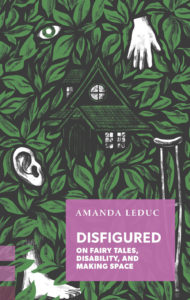February 28, 2020
Disfigured, by Amanda Leduc

While I was intrigued by the premise of Amanda Leduc’s Disfigured: On Fairy Tales, Disability, and Making Space, I wasn’t anticipating just how interesting I would find the book, as someone who can get through the day (for now, at least) without giving disability a whole lot of thought and who also didn’t grow up with a strong connection to fairy tales, Disneyfied or otherwise. A few years older than Leduc, I was lucky enough to make it out of childhood without ever longing to be Ariel and before the age when Disney started marketing dresses, so that if I’d ever wanted to dress up as a princess, I would have had to design the costume myself— and that is only part of the reason I never did.
But to say that I did not grow up in a culture steeped in the messages and symbolism of fairy tales, steeped in those stories, would be disingenuous, as Leduc makes clear in Disfigured. Because these stories are everywhere, and yes, they’re only stories… but they’re not only stories. And throughout those stories are representations of disability—hands and heads chopped off in Grimms’ tales that magically grow back, and dwarfs, and women without voices, and witches with crutches, hideously disfigured beasts, and changelings, plus fairy godmothers who exist to reverse one’s fortune.
Leduc, who has cerebral palsy, uses her own experiences (and the text includes her own childhood medical records) to tell a story of what it means when happily ever after means learning to live with one’s disability, instead of magically overcoming it—and suggests that what must be overcome is society’s ableism instead. Disfigured is gorgeously written, a fascinating blend of memoir, scholarship and cultural commentary, a quick read that’s also packed with stories about fairy tales and disability, as well as questions and curiosities. It’s the kind of book that illuminates the ordinary and points to possibilities for a better kind of world.





